Sourdough cinnamon rolls are perhaps one of the most exquisite creations to grace our taste buds since the advent of sourdough bread. The sweet stiff sourdough starter in this recipe produces a soft and fluffy texture that simply melts in your mouth. The cinnamon filling is perfectly balanced in its sweetness, making these rolls delightful on their own. However, don’t hesitate to pair them with my delectable cream cheese frosting that perfectly complements their flavor.

Personally, I find the processed, mass-produced cinnamon rolls found in grocery stores to be excessively sugary for my taste. These homemade sourdough cinnamon rolls, on the other hand, are on a whole new level and make for a fun, special holiday creation, or just for the pure joy of it!
Why I love this recipe
- Flexibility: While the process is certainly a labor of love, this recipe does allow for flexibility. For instance you can do an overnight bulk ferment or make the dough, let it proof, and refrigerate it for up to 24 hours.
- Long fermentation: The dough can be long fermented (refrigerated for up to 24 hours) making it much easier to digest. There is also no sour flavor due to the sweet stiff starter.
- Balance: The balance of flavors is just right. The cinnamon rolls are not overly sweet and the cinnamon really shines through.
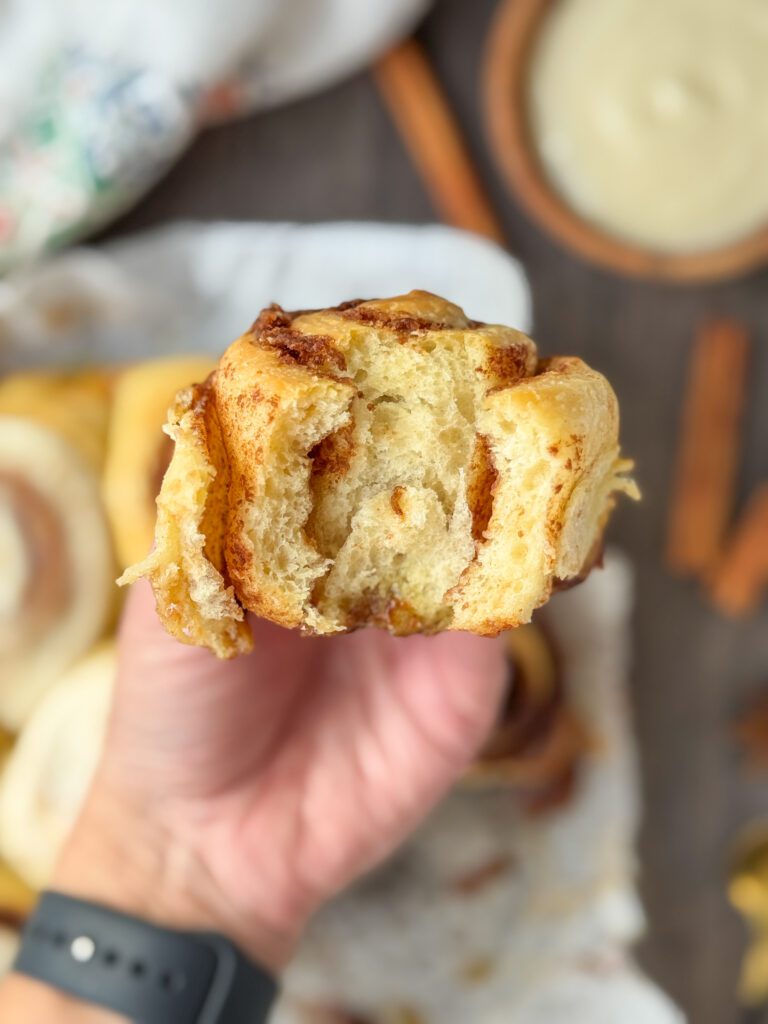
What is a sweet stiff sourdough starter?
A sweet stiff sourdough starter is a type of sourdough starter that is characterized by its low hydration and sweetness. Stiff starters typically have around 50% hydration or less, which makes them thicker and more dough-like in texture. The sweetness comes from the sugar and the natural fermentation process of the starter, which produces sugars that give the dough a sweet flavor.
Sweet stiff sourdough starters are great to use in sweet recipes where you don’t want the sourdough tang to overpower the flavor. They also produce a denser texture, which is lovely in sweet recipes. The best part about it, is it still holds all that wonderful gut nutrition!
If you want to learn more about sweet stiff starters make sure to check out my informative article and recipe here!
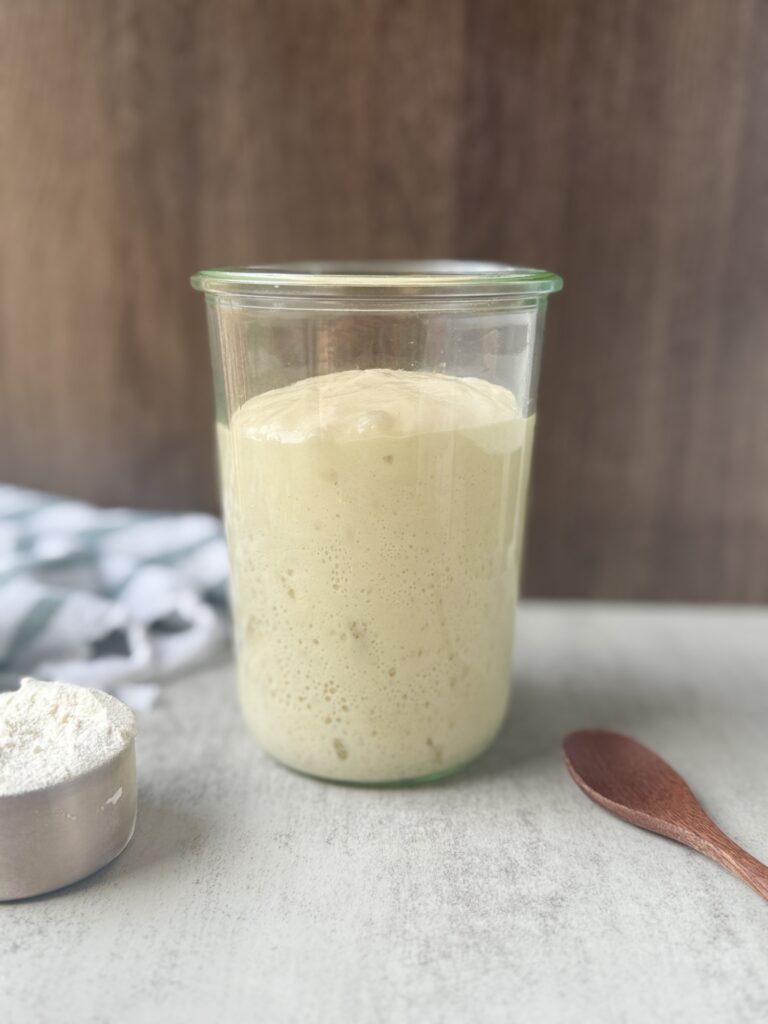
Tips before baking
- Scheduling: Make sure to check the “baker’s schedule” options in the notes section of this recipe. Every baker needs a game plan and these schedules are extremely helpful to plan when your cinnamon rolls will be ready!
- Fermentation times: Fermentation times can vary due to the temperature in your home. If you want to speed things along, place the dough in your oven with the light on. Or turn your oven on and then off to create a warm environment.
- Sweet stiff starter: Ensure your sweet stiff starter has more than doubled in size before using.
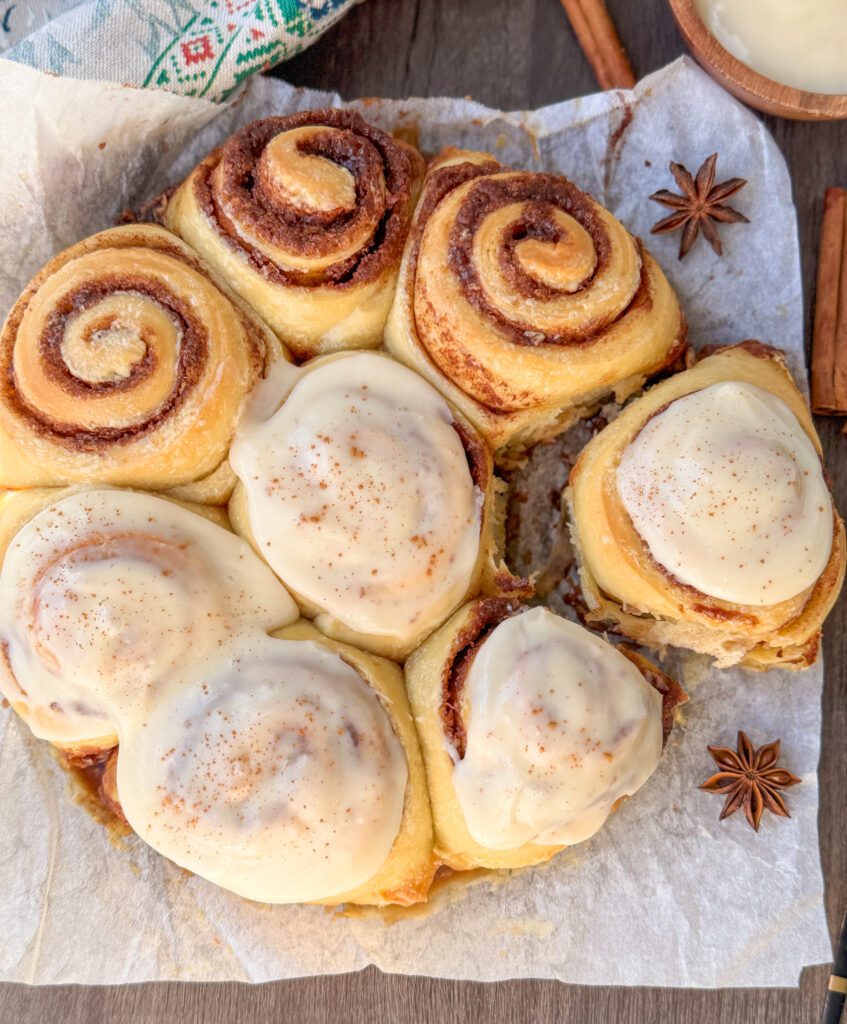
How to make sourdough cinnamon rolls: (step-by-step)
Baker’s schedule option 1:
- Make the sweet stiff starter the morning of, and mix the dough in the evening (around 7 pm) to bake for the following morning.
Baker’s schedule option 2:
- Make the sweet stiff starter the evening before you mix the dough. Mix the dough in the morning, shape and refrigerate overnight, and bake the following morning.
*Cinnamon rolls freeze well. They can be shaped and placed in the baking pan, covered with plastic wrap, and frozen for up to 3 months.
To bake frozen cinnamon rolls, remove from the freezer, remove the plastic wrap and replace it with fresh plastic wrap, and let them rest for 8-10 hours. Bake as instructed.
Equipment
- Mixing bowl
- Bench scraper
- Dough scraper
- Round 8-10-inch baking pan (spring form pan or a cast iron work well)
- Parchment paper
- Rolling pin
- Food scale
- Electric hand mixer
Ingredients
For the sweet stiff starter
- 15 grams active sourdough starter
- 15 grams of sugar
- 30 grams of water
- 60 grams of all-purpose flour
Tip: there will be about 5 grams of leftover sweet starter. This is to account for any sticking to the sides of the jar. It is better to have more than less.
Dough
- 100 grams (1/2 a cup) of sweet stiff starter from above
- 50 grams (1/4 cup) of sugar
- 160 grams (2/3 cup) of milk
- 1 large egg
- 5 grams (1 teaspoon) vanilla extract
- 57 grams (4 tablespoons) of unsalted butter (softened)
- 320 grams (2 & 2/3rd cups) of all-purpose flour
- 5 grams (1 teaspoon) of salt
The Cinnamon Filling
- 70 grams (5 tablespoons) of softened unsalted butter
- 14 grams (2 tablespoons) of cinnamon
- 50 grams (1/4 cup) of sugar
- 100 grams (1/2 cup) of brown sugar
- 8 grams (1 tablespoon) of AP flour
- 1/4 cup heavy cream for cream bath
The Frosting
- 113 grams (4 oz) of cream cheese (room temperature)
- 28 grams (2 tablespoons) unsalted butter (room temperature)
- 150-200 grams of powdered sugar (adjust to your preferred sweetness)
- 5 grams (1 teaspoon) of vanilla extract
*Optional: add a teaspoon or 2 of milk to the frosting to adjust to the desired consistency
How to make the sweet stiff starter:
- To a clean jar add the active sourdough starter.
- Next, add the water and stir until the water becomes “milky.”
- Then add the sugar and stir until most of it has dissolved.
- Lastly, add the flour and mix until no traces of flour are left. The stiff starter is dough-like and best mixed with a fork, your hand, or a silicone spatula.
- Cover the jar loosely with the cap and the starter should double in size within 8-12 hours.
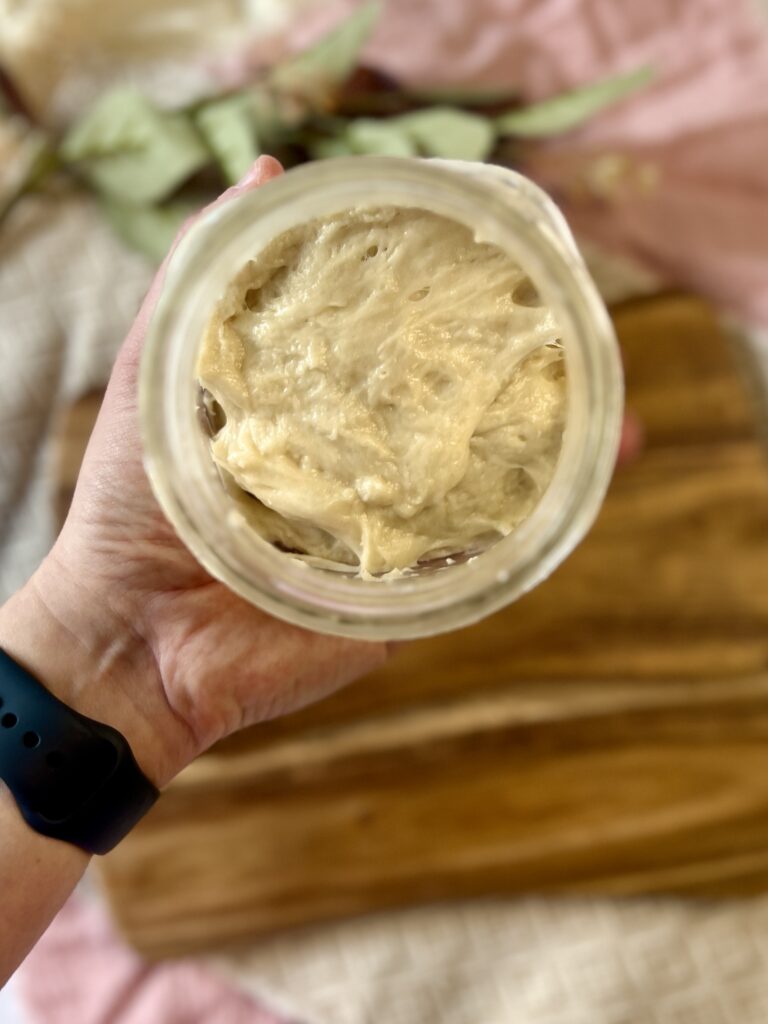
Mix the Dough
*Ensure your sweet starter has doubled in size before mixing the dough*
A stand mixer can be used to mix and knead the dough, be sure not to overwork the dough.
- Warm the milk for 20-30 seconds in the microwave and add it to a mixing bowl.
- Whisk in the sweet stiff starter and sugar using a fork or dough whisk. It’s completely fine if the sweet starter doesn’t dissolve all the way.
- Next whisk in the egg and vanilla extract until combined.

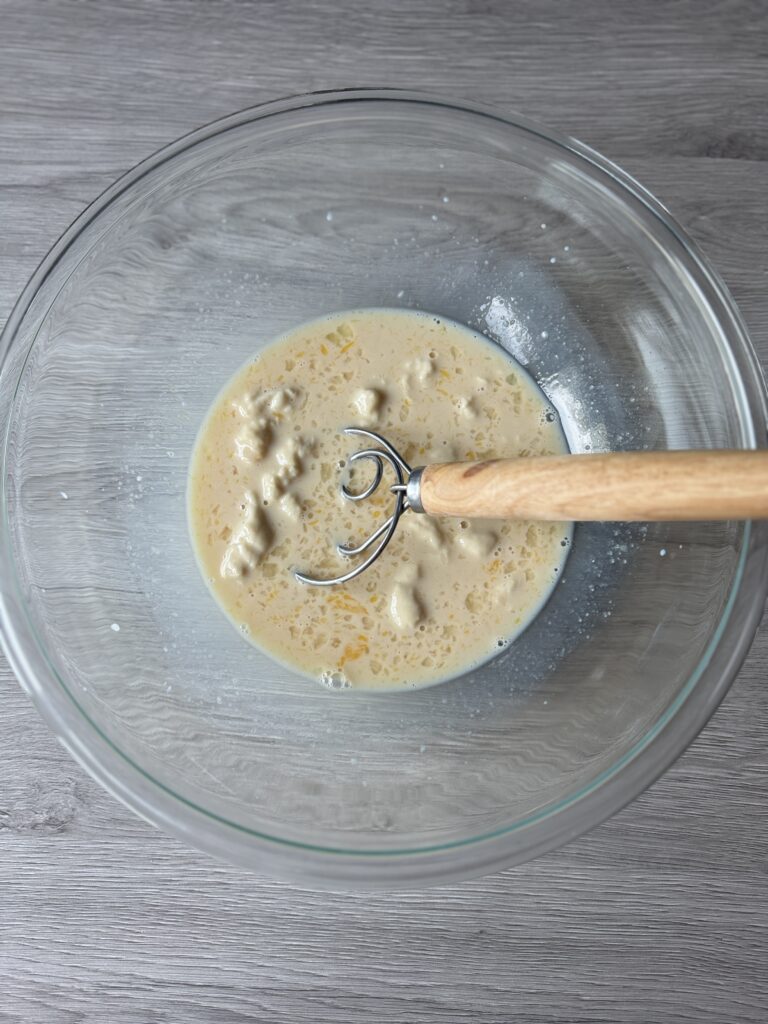
- Lastly, add the softened butter, flour, and salt. Mix until everything is well combined. It should still be fairly sticky at this stage- this is normal!
- Cover the bowl and allow it to rest for 45 minutes.
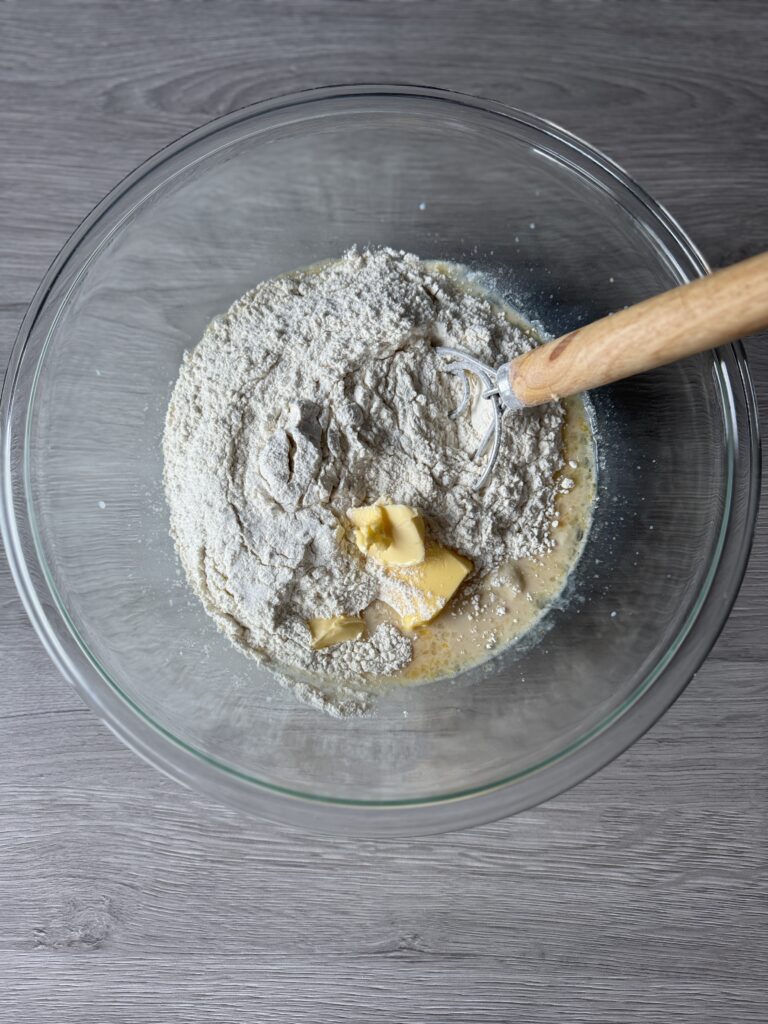
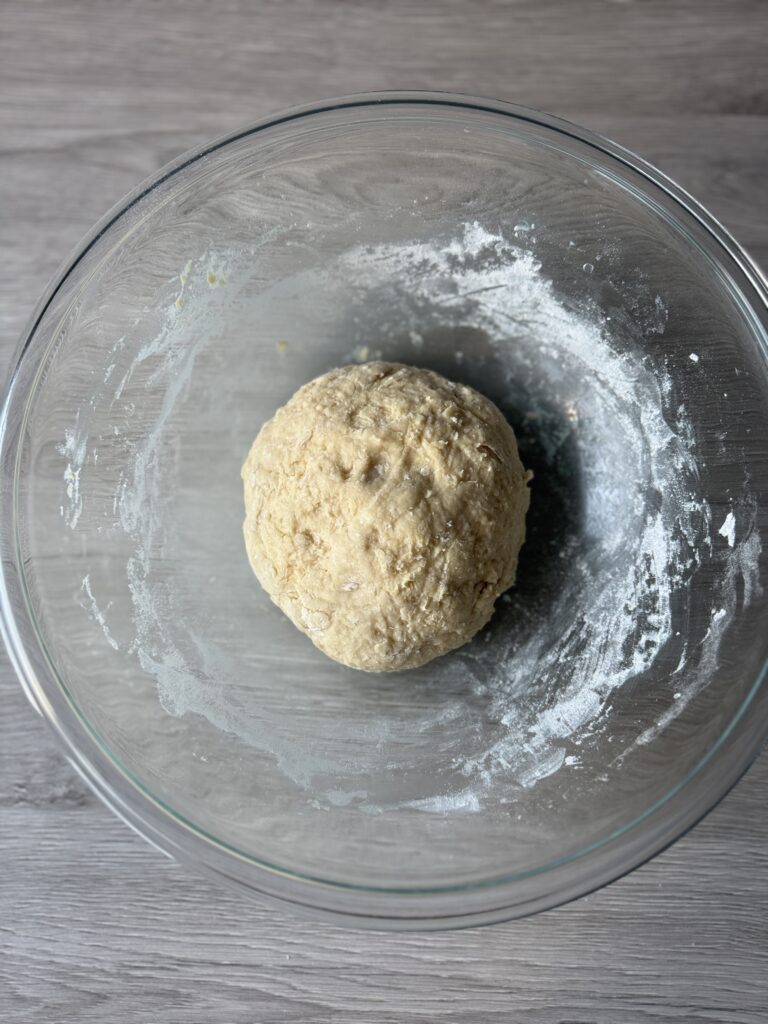
Knead the Dough
- Place the dough onto a floured work surface and knead it for 5-8 minutes or until it comes together. Use small amounts of flour during kneading to assist with stickiness. It will come together nicely with a little elbow grease and patience!
Tip: if during kneading the dough becomes excessively sticky or starts to tear, let it rest for 15 minutes. After resting return to the dough to finish kneading.
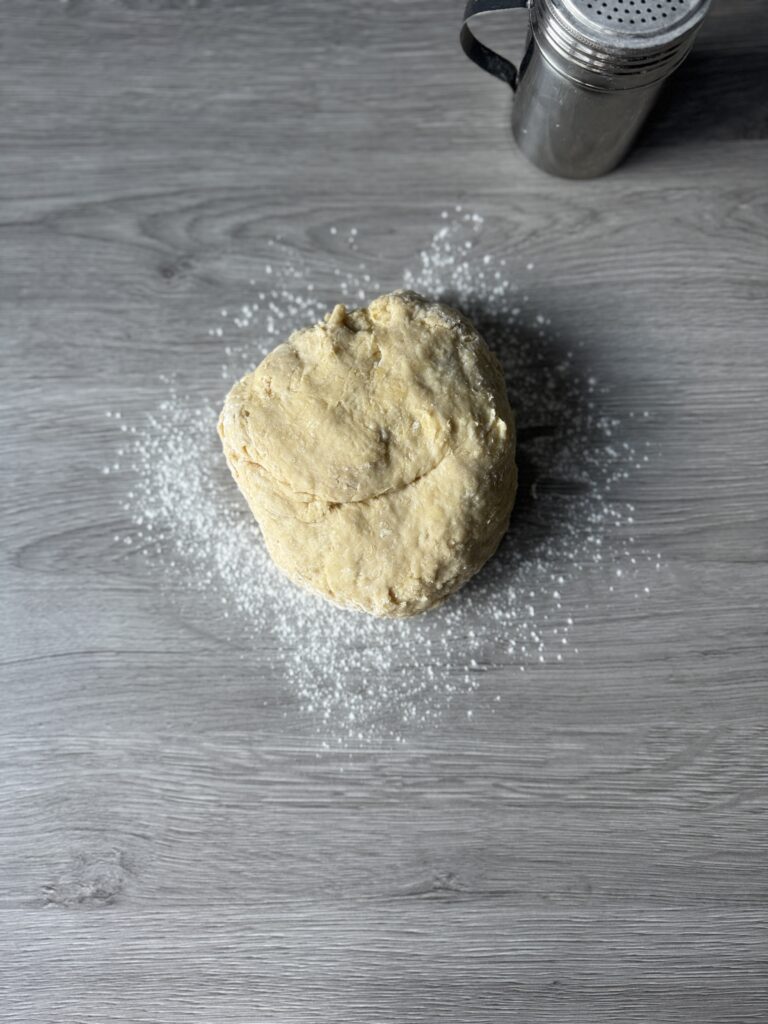
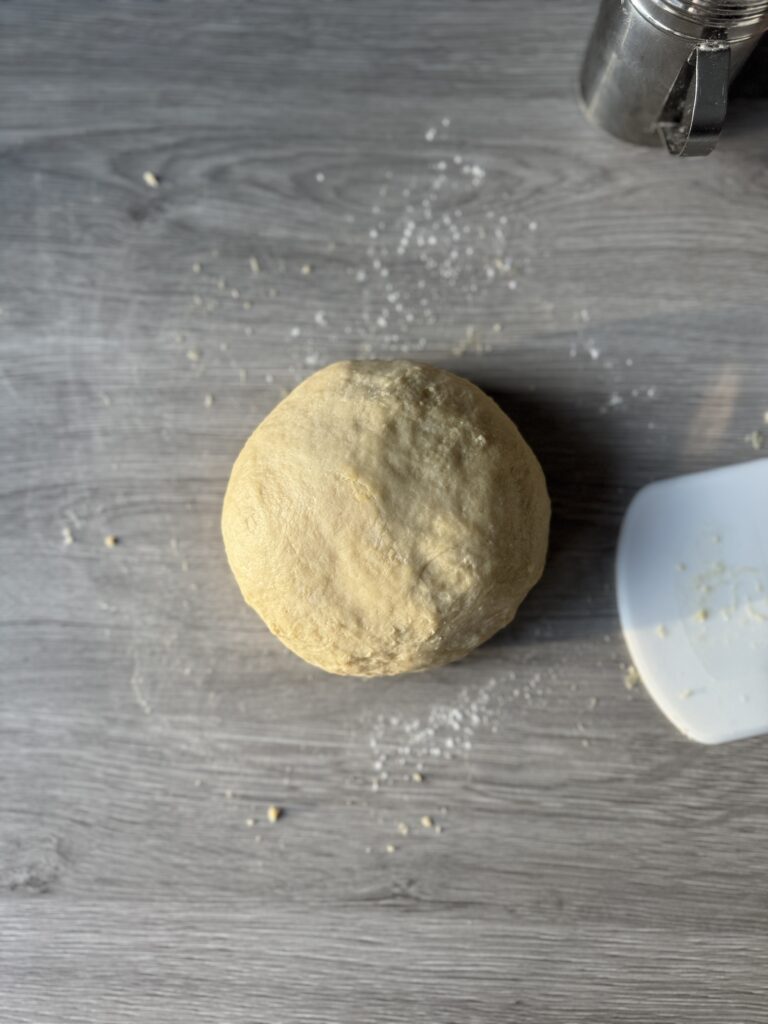
- Once complete, place the dough in a bowl coated with butter, cover it, and allow it to rest until double in size.
To speed the fermentation process up place it in your oven with the light on. Or turn the oven on and then off to create a warm environment.
- Perform 1 stretch and fold an hour into the bulk fermentation for optimal gluten development.
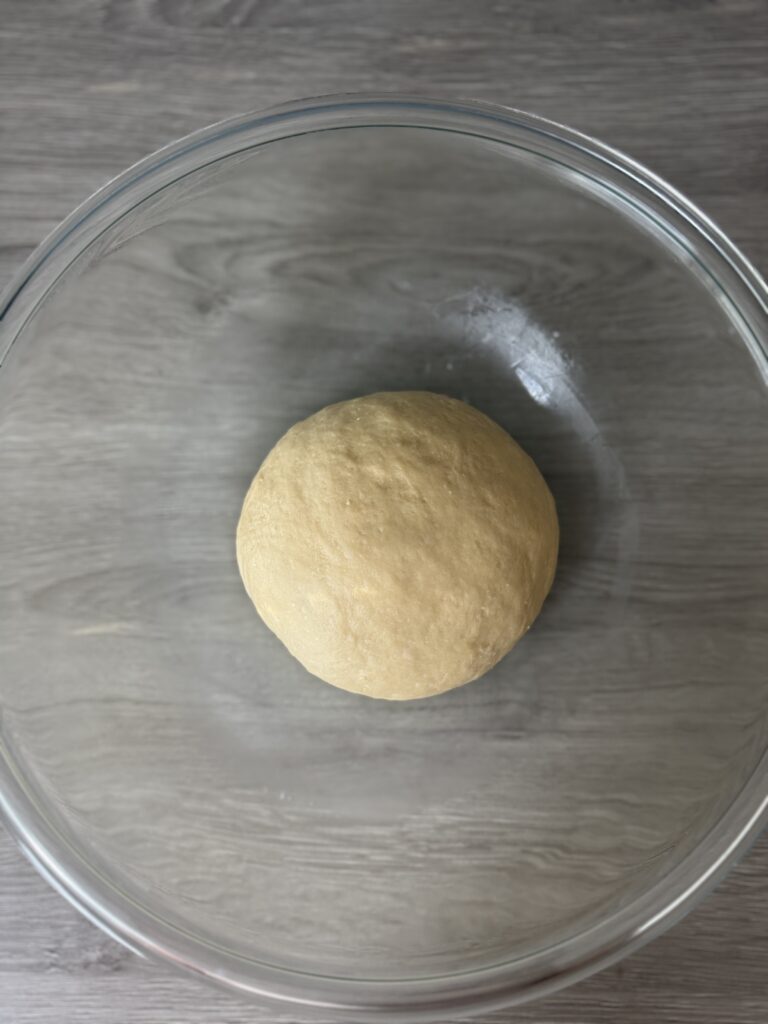
Shape the sourdough cinnamon rolls
After the dough has finished its bulk fermentation it can be placed in the refrigerator for up to 24 hours if desired.
- When the dough has doubled in size, lightly flour your work surface and turn the dough out.
- Flour both the surface of the dough and your rolling pin to avoid sticking. Roll the dough out into a 16×12 inch rectangle.
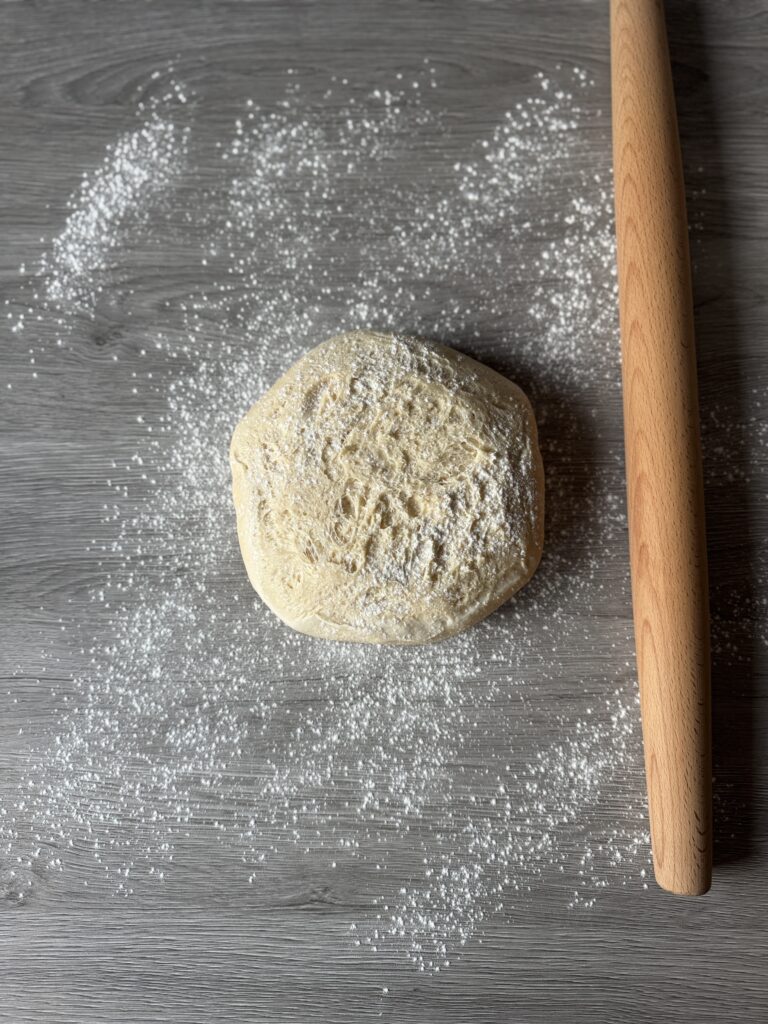
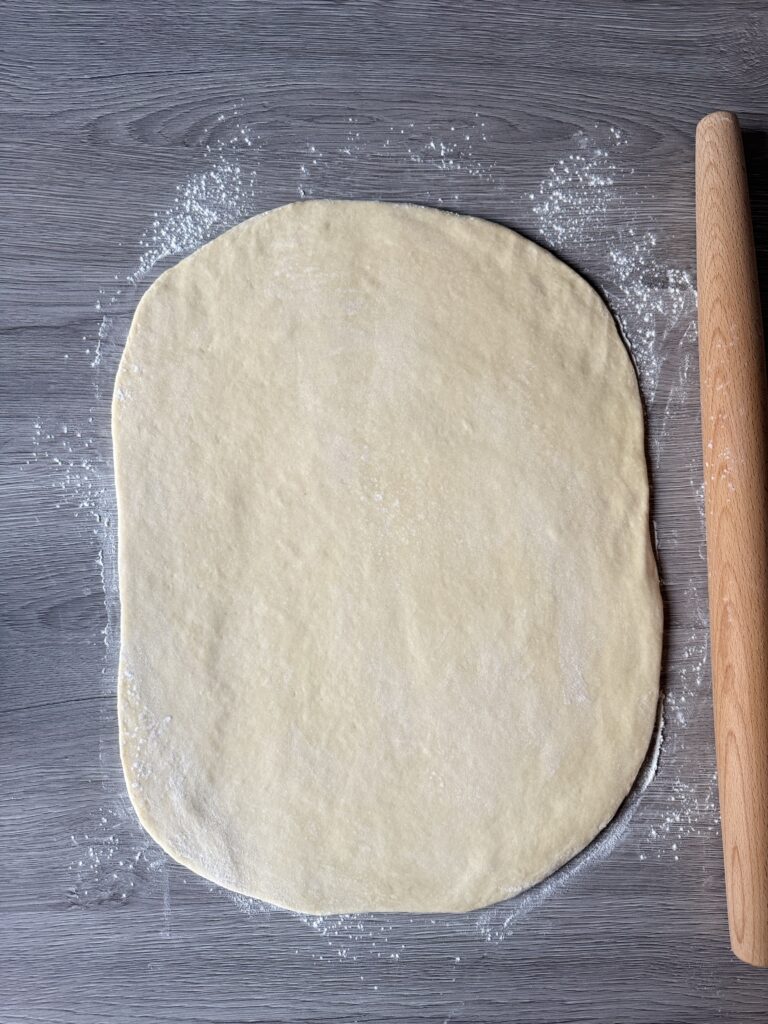
Make the cinnamon filling
- In a small bowl, add the softened butter, sugar, brown sugar, cinnamon, and flour. Mix together until a smooth, spreadable paste forms.
- If the filling feels too firm to spread, warm it for just a few seconds in the microwave or let it sit at room temperature for a few minutes. You want it soft and creamy so it spreads easily without tearing the dough.
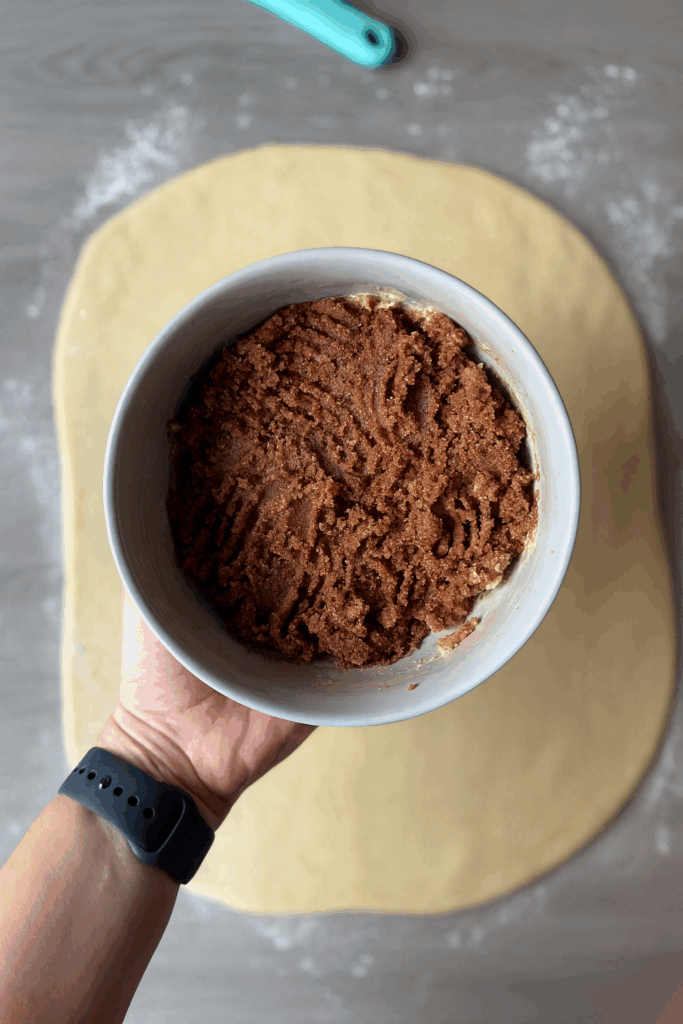
Cut and roll the sourdough cinnamon rolls
*You can roll the dough into a log and cut it, but for a more precise, uniform look, here’s my preferred method.
- Evenly spread the cinnamon filling across the dough, leaving a 1/2 to 1-inch border around the edges.
- Using a ruler or visually estimating, lightly score the top of the dough every 2 inches to help guide the cuts and maintain uniformity. Use a pizza cutter to make clean, straight cuts through the dough.
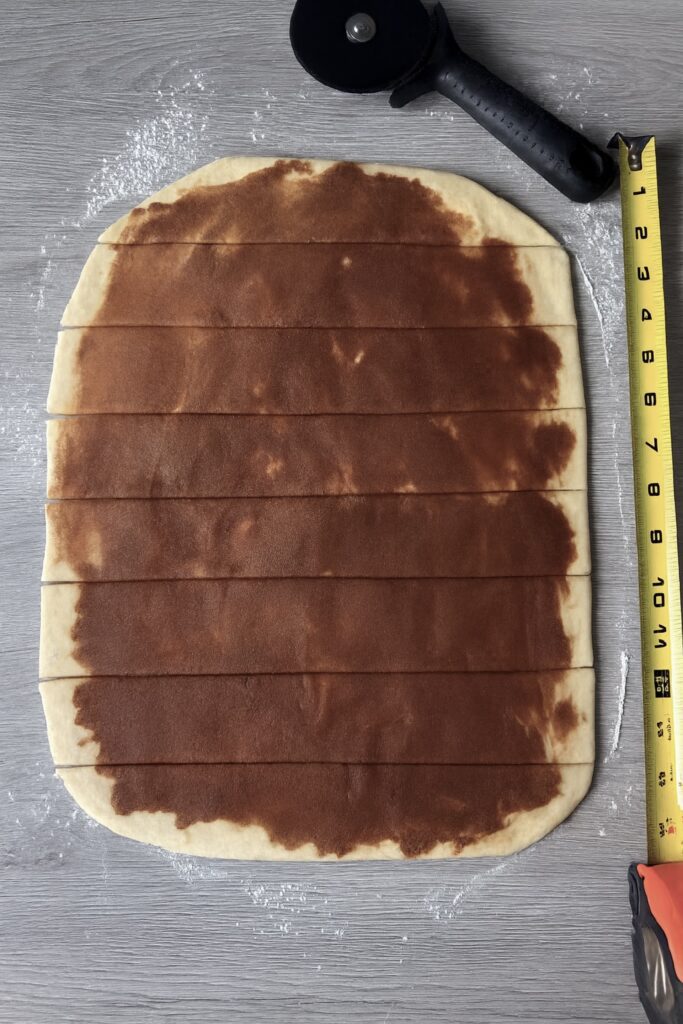
- Roll each cinnamon roll individually and place them in a parchment paper-lined pan.
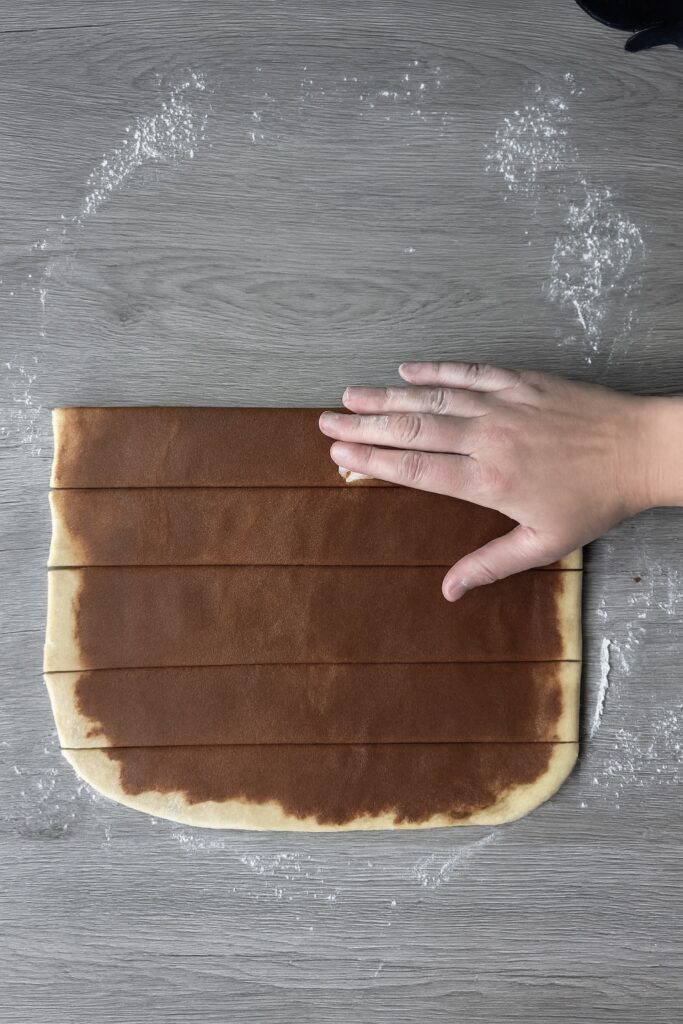
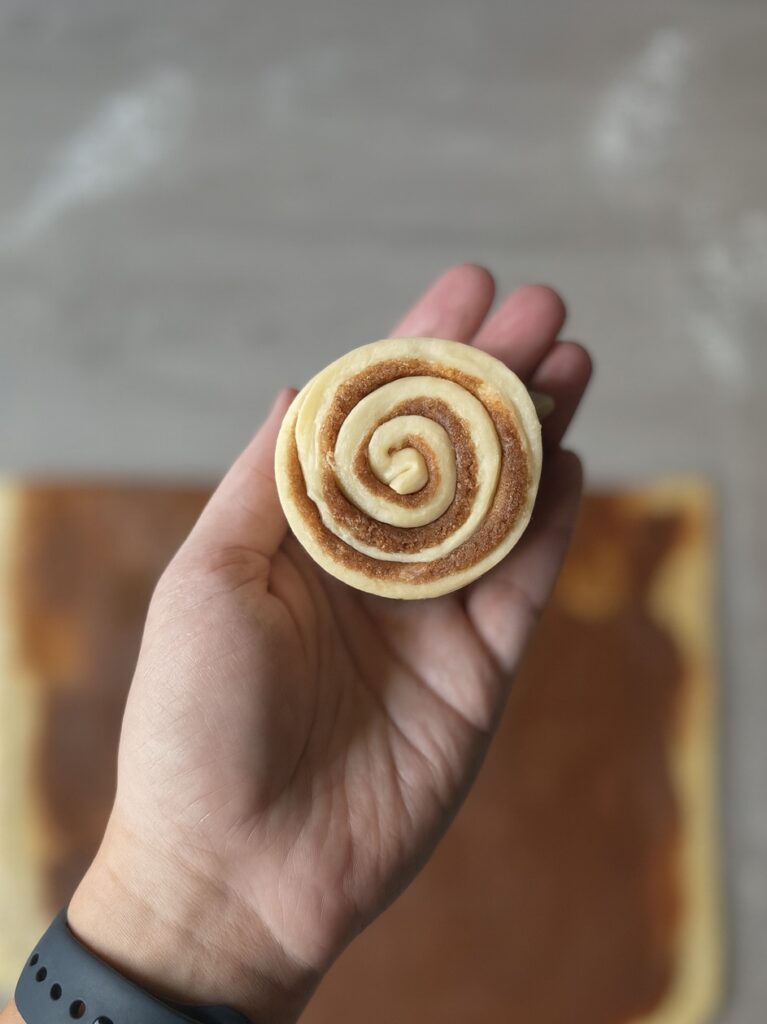
- Cover the pan with oiled plastic wrap and allow the rolls to sit for 2-3 more hours in the pan or until they have doubled in size and nearly fill the pan. Tip: turn your oven on and then off to create a warm environment for the rolls to rise.
Do not let the sourdough cinnamon rolls rest anywhere above 78 degrees during their second rise or the filling will melt out of the dough.
- The shaped cinnamon rolls can be placed in the refrigerator overnight and baked the following morning if desired.
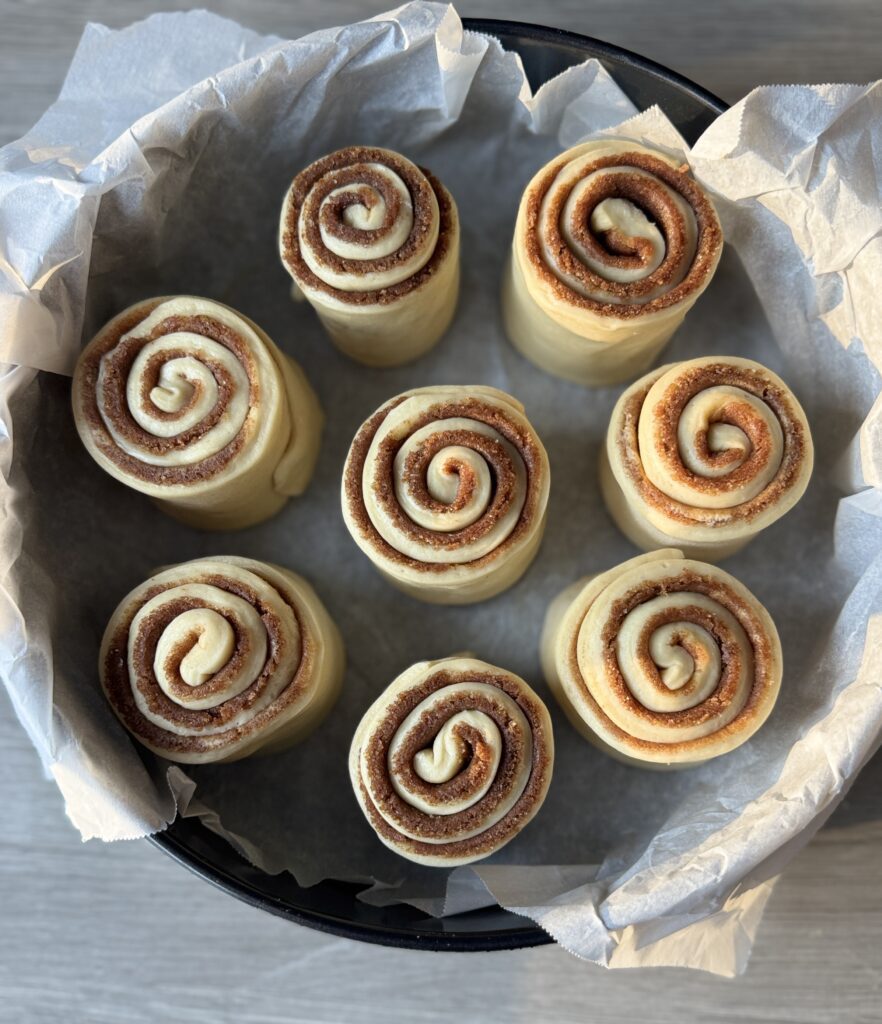
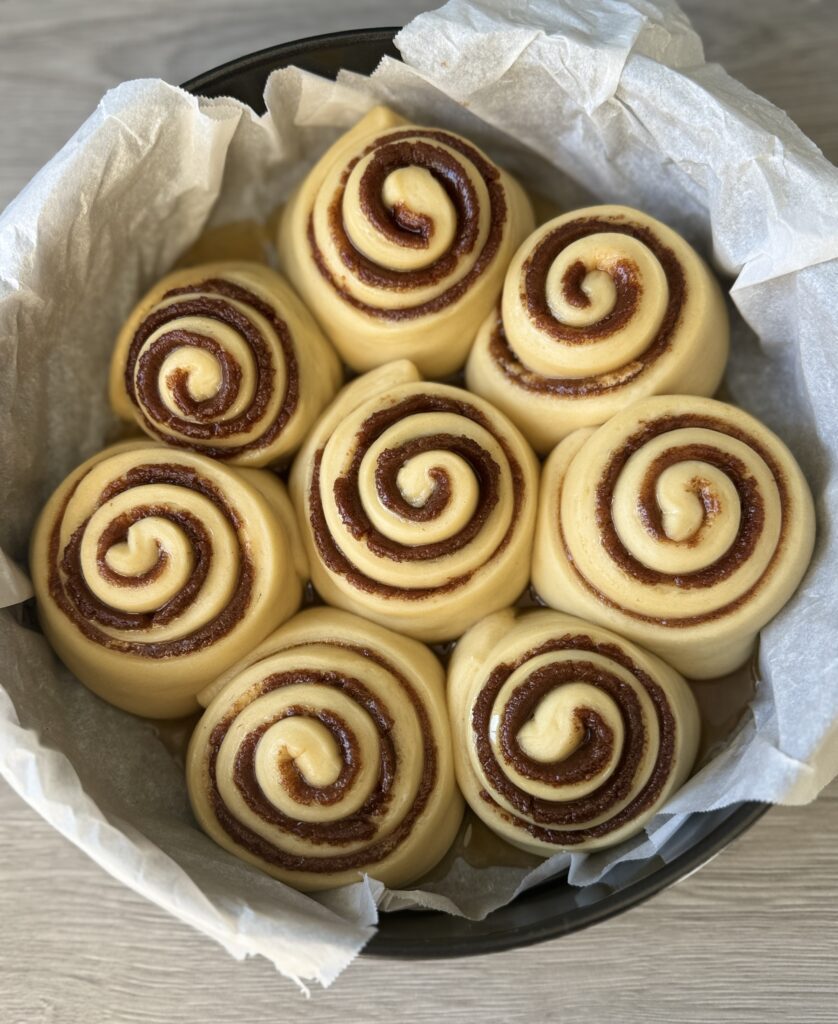
Bake the sourdough cinnamon rolls
- Preheat the oven to 350°F. Pour ¼ cup of heavy cream over the cinnamon rolls before baking for an extra soft, tender texture. Bake your cinnamon rolls on the middle rack for 35-40 minutes. Check your rolls at 35 minutes. They should be lightly golden brown and fully cooked through the center.
*The internal temperature of sourdough cinnamon rolls should be around 190-200°F (88-93°C) when they are fully cooked. You can use an instant-read thermometer to check the temperature in the center of one of the rolls.
- Once the rolls are done baking, allow them to cool for 15 minutes in the pan before transferring them to a wire rack to add the icing. Important: allowing the cinnamon rolls to rest will ensure all the dough has absorbed the butter .
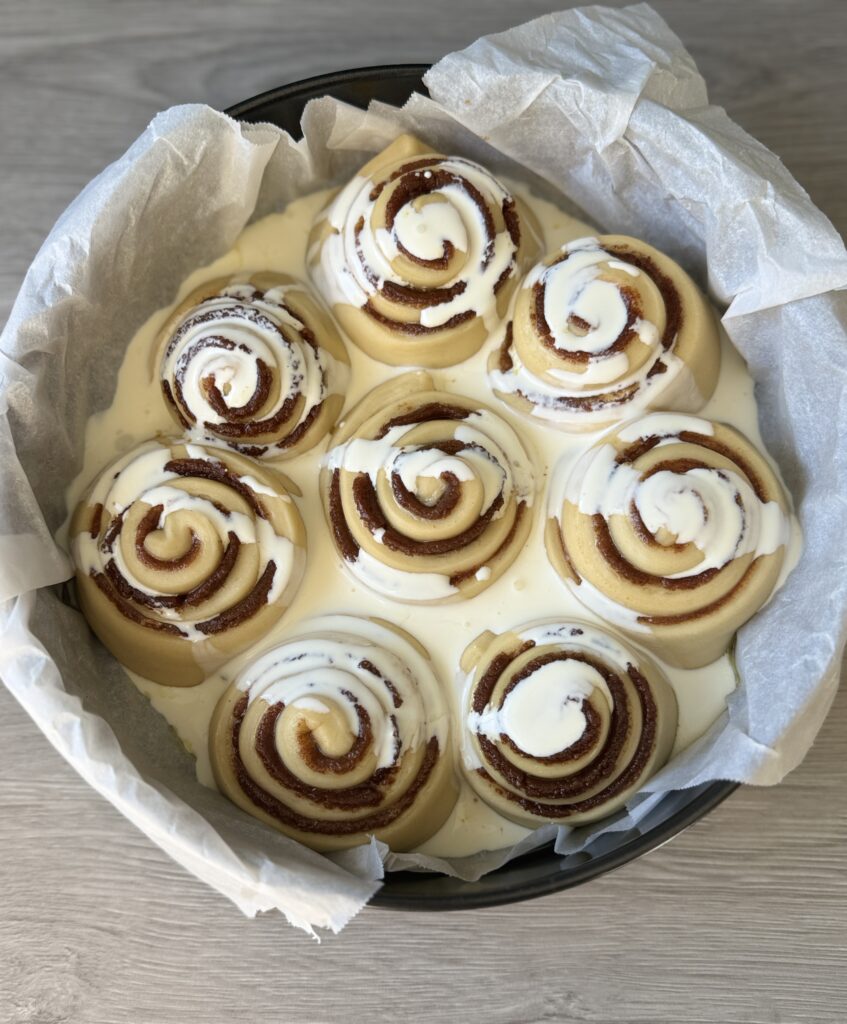
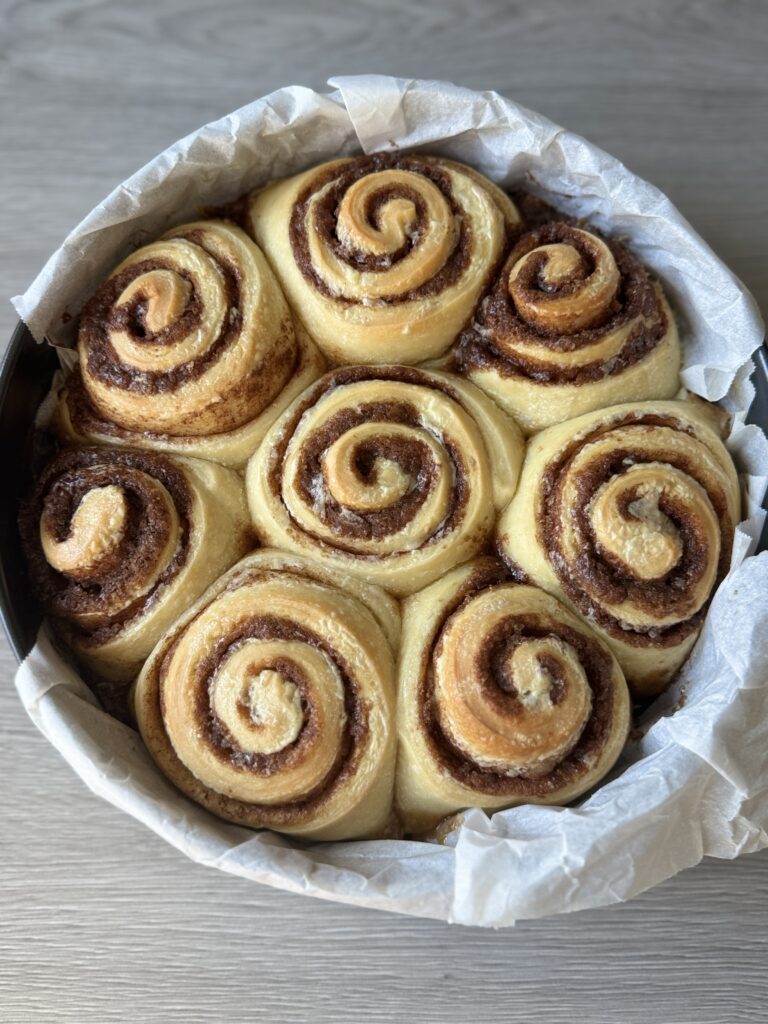
How to make the cream cheese frosting
- In a large mixing bowl, add the softened cream cheese and butter.
- Using your electric hand mixer, beat the cream cheese and butter together on medium speed. Mix until they are well combined and have a smooth, creamy texture. This should take about 2-3 minutes. Pour the vanilla extract in and mix until combined.
- Reduce the speed of your hand mixer to low. Slowly add the powdered sugar, about one cup at a time. This prevents a sugary mess and ensures that the powdered sugar is incorporated evenly into the mixture.
- Continue to blend until the frosting becomes smooth and well combined. Be sure to scrape down the sides of the bowl with a spatula to ensure even mixing. You can add a teaspoon of milk at a time if you would like a thinner consistency.
- Generously frost each cinnamon roll, and, if desired, finish with a light dusting of cinnamon on top and enjoy!
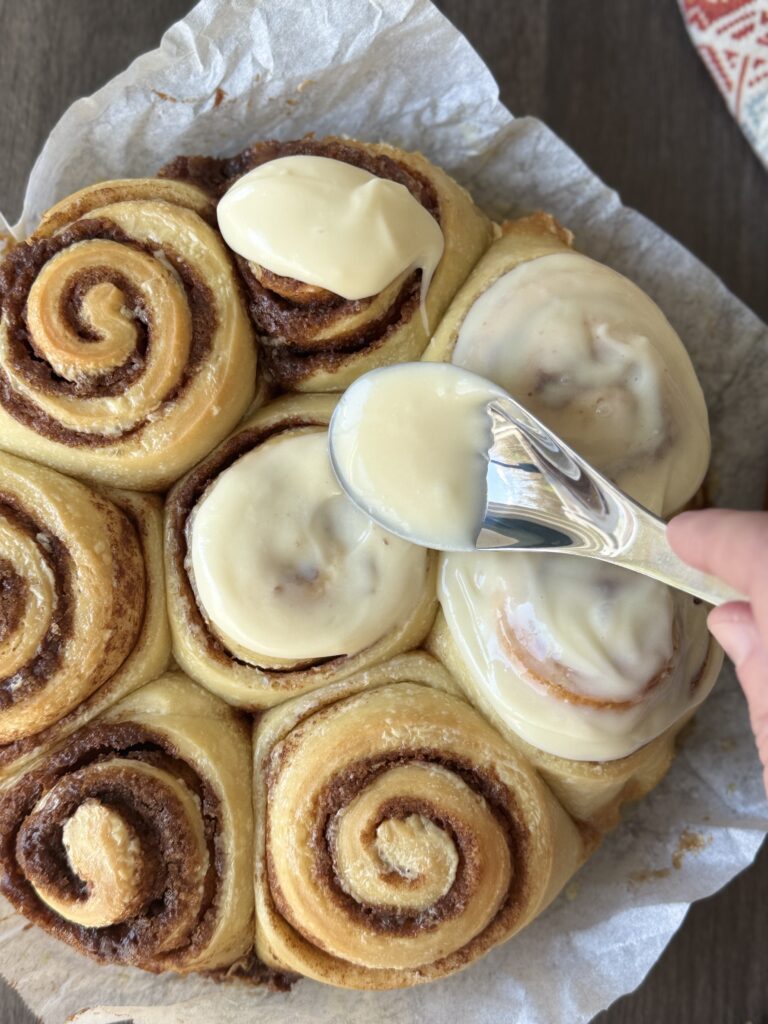
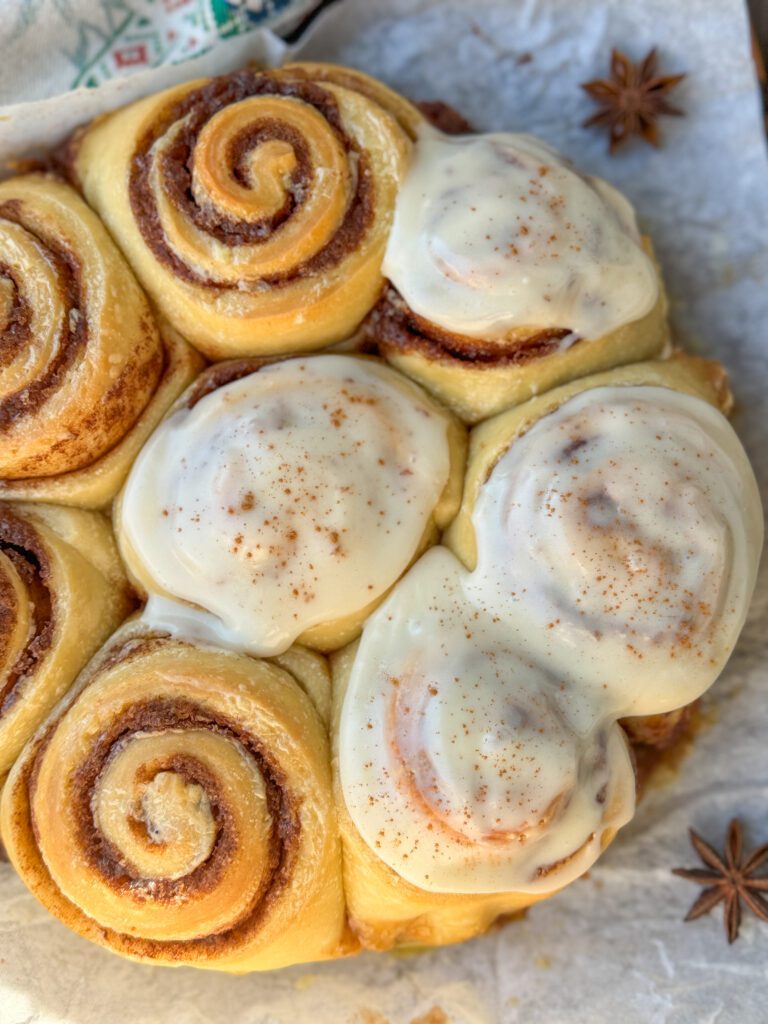
- These are best enjoyed the day they’re baked, but un-frosted rolls can be stored in an airtight container for up to 2 days on the counter-top or up to a week in the refrigerator.

More sourdough recipes like this:
- Sourdough Cinnamon Swirl Bread Wreaths
- Sourdough Discard Cinnamon Roll Muffins
- Sourdough Cinnamon Sticks (discard recipe)
- Sourdough Cinnamon Swirl Quick Bread
Sourdough cinnamon rolls (soft & not too sweet!)
Equipment
- Mixing bowl
- Bench scraper/dough scraper
- Round or square 8-10 inch baking pan spring form pan is my favorite!
- Parchment paper
- Rolling Pin
- Food scale/measuring spoons
- electric hand mixer
Ingredients
For the sweet stiff starter
- 15 grams active sourdough starter
- 30 grams water
- 15 grams sugar
- 60 grams all-purpose flour
For the dough
- 100 grams (1/2 cup) sweet stiff starter from above
- 50 grams (1/4 cup) sugar
- 160 grams (2/3rd cup) whole milk
- 1 large egg
- 5 grams (1 teaspoon) vanilla extract
- 57 grams (4 tablespoons) unsalted butter softened
- 320 grams (2 & 2/3rd cups) all-purpose flour
- 5 grams (1 teaspoon) salt
For the cinnamon filling
- 70 grams (5 tablespoons) unsalted butter softened
- 14 grams (2 tablespoons) cinnamon
- 50 grams (1/4 cup) sugar
- 100 grams (1/2 cup) brown sugar
- 8 grams (1 tablespoon) all-purpose flour
Cream bath
- 50 grams (1/4 cup) heavy cream for pouring over the rolls before baking
Cream cheese frosting
- 113 grams (4 oz) cream cheese room temp
- 28 grams (2 tablespoons) unsalted butter softened
- 150-200 grams powdered sugar adjust to your preferred sweetness
- 5 grams (1 teaspoon) vanilla extract
Instructions
How to make the sweet stiff starter:
- To a clean jar add the active sourdough starter.
- Next, add the water and stir until the water becomes “milky.”
- Then add the sugar and stir until most of it has dissolved.
- Lastly, add the flour and mix until no traces of flour are left. The stiff starter is dough-like and best mixed with a fork, your hand, or a silicone spatula.
- Cover the jar loosely with the cap and the starter should double in size within 8-12 hours.
Mix the dough
- Ensure your sweet starter has doubled in size before mixing the dough. A stand mixer can be used to mix and knead the dough, be sure not to overwork the dough.
- Warm the milk for 20-30 seconds in the microwave and add it to a mixing bowl.
- Whisk in the sweet stiff starter and sugar using a fork or dough whisk. It’s completely fine if the sweet starter doesn’t dissolve all the way.
- Next whisk in the egg and vanilla extract until combined.
- Lastly, add the softened butter, flour, and salt. Mix until everything is well combined. It should still be fairly sticky at this stage- this is normal!
- Cover the bowl and allow it to rest for 45 minutes.
Knead the Dough
- Place the dough onto a floured work surface and knead it for 5-8 minutes or until it comes together. Use small amounts of flour during kneading to assist with stickiness. It will come together nicely with a little elbow grease and patience!Tip: if during kneading the dough becomes excessively sticky or starts to tear, let it rest for 15 minutes. After resting return to the dough to finish kneading.
- Once complete, place the dough in a bowl coated with butter, cover it, and allow it to rest until double in size.To speed the fermentation process up place it in your oven with the light on. Or turn the oven on and then off to create a warm environment.
- Perform 1 stretch and fold an hour into the bulk fermentation for optimal gluten development.
Make the cinnamon filling
- In a small bowl, add the softened butter, sugar, brown sugar, cinnamon, and flour. Mix together until a smooth, spreadable paste forms.
- If the filling feels too firm to spread, warm it for just a few seconds in the microwave or let it sit at room temperature for a few minutes. You want it soft and creamy so it spreads easily without tearing the dough.
Shape the sourdough cinnamon rolls
- After the dough has finished its bulk fermentation it can be placed in the refrigerator for up to 24 hours if desired.
- When the dough has doubled in size, lightly flour your work surface and turn the dough out.
- Flour both the surface of the dough and your rolling pin to avoid sticking. Roll the dough out into a 16×12 inch rectangle.*You can roll the dough into a log and cut it, but for a more precise, uniform look, here’s my preferred method.
- Evenly spread the cinnamon filling across the dough, leaving a 1/2 to 1-inch border around the edges.
- Using a ruler or visually estimating, lightly score the top of the dough every 2 inches to help guide the cuts and maintain uniformity. Use a pizza cutter to make clean, straight cuts through the dough.
- Roll each cinnamon roll individually and place them in a parchment paper-lined pan.
- Cover the pan with oiled plastic wrap and allow the rolls to sit for 2-3 more hours in the pan or until they have doubled in size and nearly fill the pan. Tip: turn your oven on and then off to create a warm environment for the rolls to rise.Do not let the sourdough cinnamon rolls rest anywhere above 78 degrees during their second rise or the filling will melt out of the dough.
- The shaped cinnamon rolls can be placed in the refrigerator overnight and baked the following morning if desired.
Bake the sourdough cinnamon rolls
- Preheat the oven to 350°F. Pour ¼ cup of heavy cream over the cinnamon rolls before baking for an extra soft, tender texture. Bake your cinnamon rolls on the middle rack for 35-40 minutes. Check your rolls at 35 minutes. They should be lightly golden brown and fully cooked through the center.*The internal temperature of sourdough cinnamon rolls should be around 190-200°F (88-93°C) when they are fully cooked. You can use an instant-read thermometer to check the temperature in the center of one of the rolls.
- Once the rolls are done baking, allow them to cool for 15 minutes in the pan before transferring them to a wire rack to add the icing. Important: allowing the cinnamon rolls to rest will ensure all the dough has absorbed the butter .
How to make the cream cheese frosting
- In a large mixing bowl, add the softened cream cheese and butter.
- Using your electric hand mixer, beat the cream cheese and butter together on medium speed. Mix until they are well combined and have a smooth, creamy texture. This should take about 2-3 minutes. Pour the vanilla extract in and mix until combined.
- Reduce the speed of your hand mixer to low. Slowly add the powdered sugar, about one cup at a time. This prevents a sugary mess and ensures that the powdered sugar is incorporated evenly into the mixture.
- Continue to blend until the frosting becomes smooth and well combined. Be sure to scrape down the sides of the bowl with a spatula to ensure even mixing. You can add a teaspoon of milk at a time if you would like a thinner consistency.
- Generously frost each cinnamon roll, and, if desired, finish with a light dusting of cinnamon on top and enjoy!
- These are best enjoyed the day they’re baked, but un-frosted rolls can be stored in an airtight container for up to 2 days on the counter-top or up to a week in the refrigerator.
Notes
Baker’s schedule option 1:
-
- Make the sweet stiff starter the morning of, and mix the dough in the evening (around 7 pm) to bake for the following morning.
Baker’s schedule option 2:
-
- Make the sweet stiff starter the evening before you mix the dough. Mix the dough in the morning, shape and refrigerate overnight, and bake the following morning.


Leave a Comment & Rate the Recipe